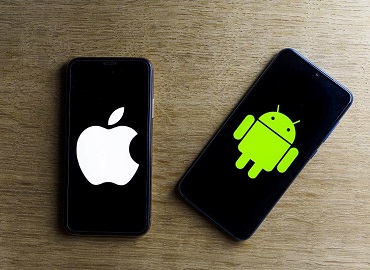iOS vs Android: Key Differences in Designing Native iOS and Android Apps
By Haziqa Ishtiaq
iOS and Android account for around 95% of the global mobile app market, with Android having a majority of the share. With such a massive market, opportunities for boosting brands and businesses are endless.
It is one reason why startups and enterprises are keen on investing in native mobile app development. Additionally, apps are a way to increase user engagement with your brand and tackle customer service issues swiftly and deftly.
Native Android and iOS apps, however, differ in more than just their market share and user base. From the programming language to the user interface, the native APIs, and more, all are significant factors that contribute to the differences between the two platforms.
If you’re developing a native app for iOS and Android, then here are some variances you should know:
App Icons
One of the fundamental differences you can spot between an iOS and Android native app is its icon. Icons are the distinct identity of a brand or application that differentiates it from other similar apps in the market.
In iOS app development, designers create icons in square shapes that are later rounded off at the corners. Apple encourages the use of flattened images to ensure clarity and transparency in the icon design. In a nutshell, since all icons have a similar shape, the square is the canvas for all designers.
On the other hand, Android app development allows a little more flexibility in icon design. Android recommends Material Guidelines for icons, but most designers do not follow them strictly. Developers can use paper shadows, an array of colors, and a transparent background, meaning Android app icons can take on any shape or form that fits the area.
App Navigation
Navigation is the primary difference in designing native apps for Android and iOS. From the buttons to the in-app navigation, various factors exist that separate the two platforms. Let’s dig deeper to understand how it affects app development:
- In-App Navigation Pattern
With the differences in device configuration, the UI of iOS and Android apps differ significantly in the way users navigate within an app.
Android apps feature an in-app navigation bar with a back button and refresh button. It allows a flawless user experience as the users can switch from one screen to the next with ease.
In iOS app development, however, a native app does not have in-built navigation. Instead, it has a screen-specific button at the top. Additionally, the only way to go back is to swipe the screen to the right. Keeping these technicalities in mind is essential for affordable web and app developers to provide a smooth user experience for the users.
- Home Button
The home button is another significant feature that differentiates the iOS and Android app design. Where the Android device has three buttons for convenience of users, iPhones only offer one button for global navigation.
The separate buttons enable users to switch screens or back out of an app anytime, without depending on the in-app button. iOS users, on the other hand, need an in-app button to go back, or they’ll be stuck on one screen.
Therefore, when designing the app UI for iOS, in particular, designers need to integrate proper navigation features within the app.
- Navigation Bar/ In-App Tab
The navigation bar is another navigation element that differs in Android and iOS apps. However, it is one factor that deals more with the position of the menu bar than the navigation.
In native Android apps, the menu tab is on the left side of the screen hidden in a drawer feature that users can access via a button on the top. The drawer holds all the options of an application that a user would need.
Contrarily, iOS apps feature navigation bars at the bottom of the screen in an app, rarely at the top, but never as a side drawer. Additionally, all the tabs are always visible on the open app screen.
Button Designs
The buttons within an app also differ for iOS and Android apps. The Material Design Guidelines offers two options for Android apps, flat and raised. Additionally, the font is capitalized in Android, but title case in iOS. Android buttons also have a shadow effect that gives them depth, a feature that is absent in iOS app buttons.
One example of button design is the vastly different CTA button in all Android apps and iOS apps:
- Call-to-Action Button
The action button represents the primary purpose of an application, like composing an email or posting updates on social apps. In iOS and Android, the CTA button is also a significant difference between Android and iOS apps.
While both platforms feature an action button, the position and design differ for iOS and Android apps. iOS apps are integrated with a more central CTA button in the middle of the navigation bar at the bottom of the screen or at the top-right corner if the navigation bar is on the top.
Contrarily, the Android apps have an analogous design for action buttons – floating action buttons on the right-bottom corner of the app.
Which Platform is the Best for You?
Apart from the variances in design, other factors also play a role in the development of iOS and Android apps. From the cost of the platform to the language the developers use, all elements contribute to their differences.
The screen resolution, the individual features of an app, its visual and style elements, are significant factors, and each characteristic contributes to the user experience. Therefore, it is essential that development agencies, like Applify Labs, consider all design elements and their effectiveness when designing native apps.

